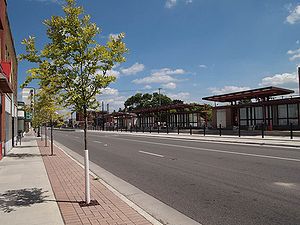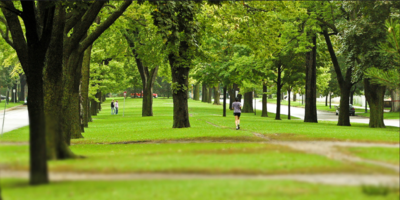
Green Infrastructure benefits of tree trenches and tree boxes
Tree trenches and tree boxes are vegetated engineered landscape practices designed to filter or infiltrate stormwater runoff. They can be incorporated into a wide variety of landscaped areas, including ultra-urban landscapes. Technically, tree boxes and tree trenches are bioretention practices, but their design, construction, maintenance, and benefits merit a separate discussion. Note that this page does not discuss urban forests and use of trees in natural landscape settings. These are discussed on a separate page.
Contents
Green Infrastructure benefits of tree trenches and tree boxes
| Benefit | Effectiveness | Notes |
|---|---|---|
| Water quality | Benefits are maximized for bioinfiltration. Biofiltration may export phosphorus if not designed properly. | |
| Water quantity/supply | Bioinfiltration helps mimic natural hydrology. Some rate control benefit. | |
| Energy savings | ||
| Climate resiliency | Provides some rate control. Impacts on carbon sequestration are uncertain. | |
| Air quality | ||
| Habitat improvement | Use of perennial vegetation and certain media mixes promote invertebrate communities. | |
| Community livability | Aesthetically pleasing and can be incorporated into a wide range of land use settings. | |
| Health benefits | ||
| Economic savings | Generally provide cost savings vs. conventional practices over the life of the practice. | |
| Macroscale benefits | Individual practices are typically microscale, but multiple practices, when incorporated into a landscape design, provide macroscale benefits such as wildlife corridors. | |
| Level of benefit: ◯ - none; ◔; - small; ◑ - moderate; ◕ - large; ● - very high | ||
Because of their diversity and use of vegetation, tree trench and tree box practices provide multiple green infrastructure benefits.
- Water quality: Tree trenches and tree boxes are an excellent stormwater treatment practice due to the variety of pollutant removal mechanisms including vegetative filtering, settling, evaporation, infiltration, transpiration, biological and microbiological uptake, and soil adsorption. Tree trenches and tree boxes can be designed as an effective infiltration / recharge practice, particularly when parent soils have high permeability (> ~ 0.5 inches per hour). Link to water quality information for tree trench/tree box - [1]
- Water quantity/supply: Tree trenches and tree boxes can be designed as an effective infiltration / recharge practice when parent soils have high permeability. Large tree trench systems can be incorporated into ultra-urban settings and provide significant volume control. For lower permeability soils an underdrain is typically used and some infiltration and rate control can be achieved.
- Climate resiliency: Properly installed and maintained trees provide significant benefits for climate resiliency. The primary benefit is through carbon sequestration. A mature tree typically sequesters about 50 pounds of carbon per year, depending on species, tree health, and tree growth rate (U.S. Department of Energy, Energy Information Administration, 1998). Nowak and Crane (2002) estimated that urban forests store about 700 million tonnes of carbon. Although carbon storage per unit area was only about half that in forested areas, urban forests grow quickly and trees reach maturity sooner compared to natural forests.
- Habitat improvement:

Tree ordinances
A tree ordinance is a tool to help protect and manage a community’s trees. It can be designed to regulate various aspects of tree planting, removal, and maintenance on public and private property within a municipality. For more general information on tree ordinances, link here: [2], [3], or [4].
- City of Maplewood, Minnesota
- Lancaster, Pennsylvania
- Dallas, Texas
- Arbor Day Foundation
- Ordinance on vegetation and disease control - City of St. Louis Park
- Ordinance on vegetation and disease control - City of Hayfield
- Model landscape ordinance
Urban forest management master plans
An urban forest master plan provides a road map for managing trees and the tree canopy in an urban area. The master plan typically includes detailed information, recommendations, and resources needed to manage an urban forest. An important component of a good forest master plan is engaging citizens and other stakeholders in the value and care of the urban forest.
A master plan may contain some or all of the following elements.
- Need and authorization, such as the need for ordinances
- Background information, such as historical and current condition of urban forest
- Public participation process
- Urban forest functions and benefits
- Urban forest vision
- Urban forest goals and objectives
- Implementation strategies
- Implementation and phasing
- Monitoring and protection strategy
- Limitations
Example master plans are found at the following links.
- Pittsburgh, Pennsylvania
- Palo Alto, California
- Syracuse, New York
- SanFrancisco, California
- Missoula, Montana
Recommended reading
- Stormwater to Street Trees. US EPA 841-B-13-001September 2013.
References
- Adger, W. Neil. 2006. Vulnerability. Global Environmental Change 16:268–281.
- Barton, S. 2009. Human benefits of green spaces. University of Delaware Bulletin #137. 2009.
- Folke C. 2006. Resilience: the emergence of a perspective for social–ecological systems analyses. Global Environ Change. 16:253–267.
- Kazemi, F., S. Beecham, J. Gibbs, and R. Clay. 2009. Factors affecting terrestrial invertebrate diversity in bioretention basins in an Australian urban environment. Landscape and Urban Planning. Vol. 92:3-4:304-313.
- Kazemi, F., S. Beecham, and J. Gibbs. 2009. Streetscale bioretention basins in Melbourne and their effect on local biodiversity. Ecological Engineering. 35:1454-1465.
- Mehring, A.S., B. E. Hatt, D. Kraikittikun, B. D. Orelo, M. A. Rippy, S. B. Grant, J. P. Gonzalez, S. C. Jiang, R. F. Ambrose, and L. A. Levin. 2016. Soil invertebrates in Australian rain gardens and their potential roles in storage and processing of nitrogen. Ecological Engineering. 97:138-143.
- Moore, T., and W.F. Hunt. 2013. Predicting the carbon footprint of urban stormwater infrastructure. Ecological Engineering. Volume 58, September 2013, Pages 44-51.
- New York City Mayor’s Office of Recovery and Resiliency. 2017. Preliminary Climate Resiliency Design Guidelines.
